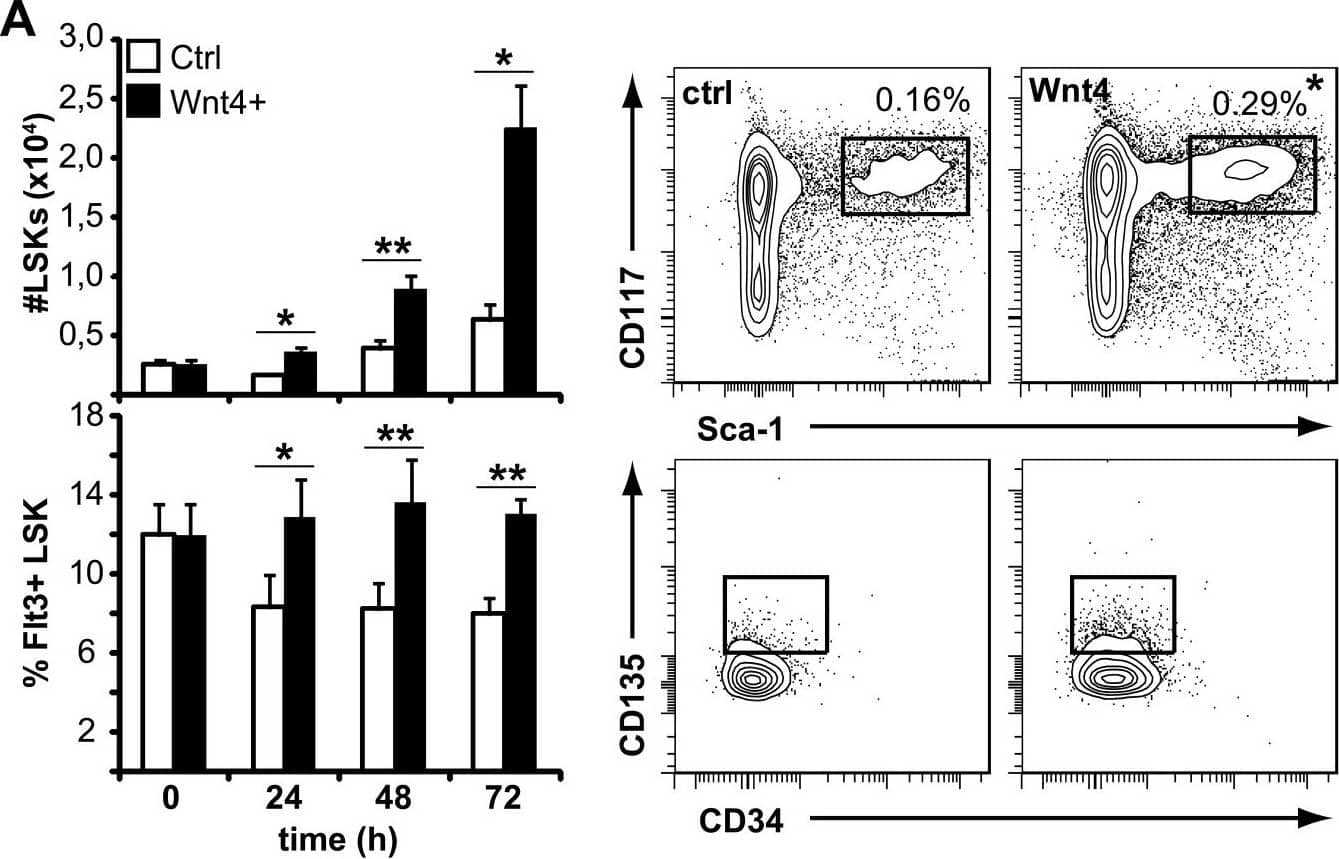Mouse Wnt-4 Antibody
R&D Systems, part of Bio-Techne | Catalog # AF475


Key Product Details
Species Reactivity
Validated:
Cited:
Applications
Validated:
Cited:
Label
Antibody Source
Product Specifications
Immunogen
Ile37-Glu76, Arg222-Thr295
Accession # P22724
Specificity
Clonality
Host
Isotype
Scientific Data Images for Mouse Wnt-4 Antibody
Detection of Wnt-4 by Flow Cytometry
Wnt4 enhances LSK expansion in culture via JNK-dependent mechanisms.A) Fetal liver cells cultured on NIH3T3 or NIH3T3-Wnt4 cells for 24–72 h&the proportion&number of LSKs analyzed by flow cytometry at different time points. Histograms on the left show absolute numbers of LSKs&the %age of LSKs expressing high levels of Flt3 (mean ± SEM; n = 7). Representative flow cytometry data for both Wnt4 (▪)&control (□) cultures after 48 h are shown on the right. Numbers in the upper-right corners of the FACS panels represent the %age of LSKs over total live events. *P≤0.05, **P≤0.005, Wnt4 vs control (paired). Image collected & cropped by CiteAb from the following open publication (https://pubmed.ncbi.nlm.nih.gov/21541287), licensed under a CC-BY license. Not internally tested by R&D Systems.Applications for Mouse Wnt-4 Antibody
Immunohistochemistry
Sample: Immersion fixed paraffin-embedded sections of rat embryo (E15)
Western Blot
Sample: Recombinant Mouse Wnt‑4
Reviewed Applications
Read 1 review rated 4 using AF475 in the following applications:
Formulation, Preparation, and Storage
Purification
Reconstitution
Formulation
Shipping
Stability & Storage
- 12 months from date of receipt, -20 to -70 °C as supplied.
- 1 month, 2 to 8 °C under sterile conditions after reconstitution.
- 6 months, -20 to -70 °C under sterile conditions after reconstitution.
Background: Wnt-4
Wnt-4 is a 38‑42 kDa member of the Wnt family of secreted glycoproteins, which act as short-range signaling molecules via Frizzled receptors and a cascade of intracellular signals in vertebrate embryogenesis (1‑2). Mouse Wnt-4 is synthesized as a 351 amino acid (aa) precursor with a 22 aa signal sequence and a 329 aa mature chain. The mature chain contains two potential sites for N-linked glycosylation. Relative to other members of the Wnt family, Wnt-4 contains 83 conserved aa, including 21 cysteines (1). Mature mouse Wnt-4 shares 99% aa sequence identity with mature human and rat Wnt-4. Wnt-4 has been shown to play a critical role in the development of the reproductive system and in the formation of the kidneys, adrenals, pituitary gland, and mammary tissues (3‑6). In the development of the reproductive system, Wnt-4 expression is down-regulated in the developing gonad after E11.5, although it persists in the developing ovary (2, 6). Targeted deletion of Wnt-4 results in masculinization of XX mice, with rudimentary development of the masculine internal (Wolffian) ducts and degeneration of the female (Mullerian) reproductive tract (2, 6). In addition to its involvement in urogenital development, Wnt-4 is also expressed in the perichondrium of the long bones (7), and promotes osteoblast differentiation (8). Wnt-4 may also be associated with abnormal proliferation in human breast tissue (9). In humans, mutations in Wnt-4 are the cause of SERKAL syndrome, a syndrome consisting of female to male sex reversal, renal, adrenal, and lung dysgenesis, and developmental defects (3), and Rokitansky-Kuster-Hauser syndrome, which is characterized by utero-vaginal atresia in otherwise phenotypically normal females with normal 46, XX karyotype (10).
References
- Gavin, B.J. et al. (1990) Genes Dev. 4:2319.
- Jordan, B.K. et al. (2001) Am. J. Hum. Genet. 68:1102.
- Mandel, H. et al. (2008) Am. J. Hum. Genet. 82:39.
- Bernard, P. and V.R. Harley (2007) Int. J. Biochem. Cell Biol. 39:31.
- Kuulasmaa, T. et al. (2008) Horm. Metab. Res. 40:668.
- Vainio, S. et al. (1999) Nature 397:405.
- Gao, X. (2004) Genes Dev. 18:2404.
- Chang, J. et al. (2007) J. Biol. Chem. 282:30938.
- Huguet, E.L. et al. (1994) Cancer Res. 54:2615.
- Philibert, P. et al. (2008) J. Clin. Endocrinol. Metab. 93:895.
Long Name
Alternate Names
Gene Symbol
UniProt
Additional Wnt-4 Products
Product Documents for Mouse Wnt-4 Antibody
Product Specific Notices for Mouse Wnt-4 Antibody
For research use only